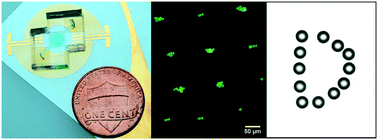Our official English website, www.x-mol.net, welcomes your feedback! (Note: you will need to create a separate account there.)
Acoustic tweezers based on circular, slanted-finger interdigital transducers for dynamic manipulation of micro-objects.
Lab on a Chip ( IF 6.1 ) Pub Date : 2020-03-03 , DOI: 10.1039/c9lc01124b Putong Kang 1 , Zhenhua Tian 2 , Shujie Yang 1 , Wenzhuo Yu 1 , Haodong Zhu 1 , Hunter Bachman 1 , Shuaiguo Zhao 1 , Peiran Zhang 1 , Zeyu Wang 1 , Ruoyu Zhong 1 , Tony Jun Huang 1
Lab on a Chip ( IF 6.1 ) Pub Date : 2020-03-03 , DOI: 10.1039/c9lc01124b Putong Kang 1 , Zhenhua Tian 2 , Shujie Yang 1 , Wenzhuo Yu 1 , Haodong Zhu 1 , Hunter Bachman 1 , Shuaiguo Zhao 1 , Peiran Zhang 1 , Zeyu Wang 1 , Ruoyu Zhong 1 , Tony Jun Huang 1
Affiliation

|
Acoustic tweezing technologies are gaining significant attention from the scientific communities due to their versatility and biocompatibility. This study presents acoustic tweezers based on circular, slanted-finger interdigital transducers (CSFITs), which can steer the propagation direction of surface acoustic waves (SAWs) by tuning the excitation frequency. The CSFITs based acoustic tweezers enable dynamic and reconfigurable manipulation of micro-objects using multi-tone excitation signals. Compared to traditional interdigital transducers that generate and control SAWs along one axis, the CSFITs allow for simultaneously generating and independently controlling SAWs propagating along multiple axes by changing the frequency composition and the phase information in a multi-tone excitation signal. Moreover, the CSFITs based acoustic tweezers can be used for patterning cells/particles in various distributions and translating them along complex paths. We believe that our design is valuable for cellular-scale biological applications, in which on-chip, contactless, biocompatible handling of bioparticles is needed.
中文翻译:

基于圆形斜指叉指传感器的声学镊子,用于动态操纵微型物体。
声学镊子技术由于其多功能性和生物相容性而受到科学界的广泛关注。这项研究提出了基于圆形斜指叉指换能器(CSFIT)的声学镊子,它可以通过调节激励频率来控制表面声波(SAW)的传播方向。基于 CSFIT 的声学镊子能够使用多音激励信号对微观物体进行动态和可重构的操纵。与沿一个轴生成和控制 SAW 的传统叉指换能器相比,CSFIT 允许通过改变多音激励信号中的频率组成和相位信息来同时生成和独立控制沿多个轴传播的 SAW。此外,基于 CSFIT 的声学镊子可用于对各种分布的细胞/颗粒进行图案化,并沿着复杂的路径平移它们。我们相信,我们的设计对于细胞规模的生物应用很有价值,其中需要对生物颗粒进行片上、非接触式、生物相容性处理。
更新日期:2020-03-03
中文翻译:

基于圆形斜指叉指传感器的声学镊子,用于动态操纵微型物体。
声学镊子技术由于其多功能性和生物相容性而受到科学界的广泛关注。这项研究提出了基于圆形斜指叉指换能器(CSFIT)的声学镊子,它可以通过调节激励频率来控制表面声波(SAW)的传播方向。基于 CSFIT 的声学镊子能够使用多音激励信号对微观物体进行动态和可重构的操纵。与沿一个轴生成和控制 SAW 的传统叉指换能器相比,CSFIT 允许通过改变多音激励信号中的频率组成和相位信息来同时生成和独立控制沿多个轴传播的 SAW。此外,基于 CSFIT 的声学镊子可用于对各种分布的细胞/颗粒进行图案化,并沿着复杂的路径平移它们。我们相信,我们的设计对于细胞规模的生物应用很有价值,其中需要对生物颗粒进行片上、非接触式、生物相容性处理。


























 京公网安备 11010802027423号
京公网安备 11010802027423号